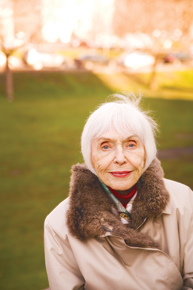Hats off to the grande dame of Radio-Canada
Hats off to the grande dame of Radio-Canada McGill University
User Tools (skip):
Hats off to the grande dame of Radio-Canada
Completes BA 70 years and a lifetime of accomplishment after freshman year

Tisseyre: A life well-lived
CLAUDIO CALLIGARIS
In 1924, 16-year-old Michelle Tisseyre stood at a crossroads in her life and looked to her father, John G. Ahern, for guidance. He told her that she could do as so many young women of her generation did; have a coming out ball, get married and settle into the domestic life. Or, he suggested, she could go to university and get an education because, "You never know what might happen." Between her enrollment as an Arts undergrad in 1936 and her eventual graduation some 70 years later, something did happen — something called life. And, oh, what a life it has been.
Tisseyre's initial studies in history and philosophy lasted but a year before she left school to get married, moved to the Laurentians and had her first of five children. That year proved invaluable when, in 1941, her husband was shipped overseas to fight. "I had never been on my own until I went to McGill," she remembers. "It taught me how to fend for myself."
Suddenly a single mother with little income, Tisseyre applied to the CBC for a job because so many journalists were in Europe working as war correspondents. Perfectly bilingual, she not only passed the auditions, but excelled in a male-dominated newsroom to become the first female to anchor the "Grand Journal" newscast.
War's end did not usher in the anticipated period of renewal for many couples divided so long by the yawning chasm of the Atlantic Ocean. Tisseyre and her husband applied for a divorce — among the first French Canadians to do so, and needed a special bill passed in Senate in order for the marriage to be dissolved.
Continuing her career as a broadcast journalist, she met Pierre Tisseyre, a Belgian officer who had emigrated to Canada after his release from three years of captivity in a German POW camp. In 1948, they wed, forming a 48-year bond marked by love and unbridled creativity. "Pierre was always so enthusiastic about everything I did," she says. "He gave me confidence to try new things."
Television trailblazer
In 1953, Radio-Canada hit the television airwaves. Hosting Rendez-vous avec Michelle, Canada's first-ever talk show, Tisseyre became a household name for the on-air flair that would become her trademark. In one pre-arranged stunt, the slender Tisseyre ended an interview with a 6'4" judo world champion by tossing him over her hip when he became belligerent.
Her showmanship made her a natural as host of Music-Hall, the province's first large-scale variety show. Attracting the top French stars of the era, including Edith Piaf and Charles Aznavour, she went head-to-head with Ed Sullivan, whipping the legendary impresario regularly in the Quebec ratings.
She continued her trail-blazing ways as the co-host of Radio-Canada's first major daily public affairs program, Aujourd'hui, which ran from 1962-70.
Then, in the early 1970s, Tisseyre made a career change. While convalescing from crippling arthritis, she came across the writings of Morley Callaghan and was enthralled. "I called him up right away and said 'I've just discovered you. Please, please, please can I translate you?'" Tisseyre and her husband founded La Collection des deux Solitudes in order to translate iconic English Canadian authors such as Callaghan, Margaret Laurence, W.O. Mitchell and Robertson Davies for French readers. She went on to be named an Officer of the Order of Canada for her publishing work.
Of the celebrities she has met during her storied career, Tisseyre remembers Piaf for always being wrapped up in bulky sweaters to ward off her painful rheumatism and Callaghan for always calling her "my Irish girl." "Most celebrities at that time were so simple, so unassuming," she says. "But it has become a mad, mad world today."
Nothing left undone
Following her husband's death in 1995, Tisseyre decided to return to McGill to complete her BA. Enrolled in Honours Italian with a minor in Art History in 2001, Tisseyre admits that she felt some trepidation. "I was afraid that the young people would look at me and say 'Who is this old dame?'" When things got hairy during exams, Tisseyre was able to commiserate with her granddaughter Sacha, a commerce undergrad slated to graduate in 2007.
The decades between classes had done nothing to dampen her spirit or ability to fit in. "I've felt comfortable right from the start," says the grandmother of 28 and great-grandmother of 10. "It's been just wonderful having people come up to me and say 'I want to be just like you when I get older.' Isn't that nice? Older, not old."
At Convocation, when the 88-year-old walked across the stage of Salle Wilfred Pelletier with the help of a cane, her grey hair standing out against the jet-black gown, the entire room stood for an extended ovation. "It was very emotional for me," says Tisseyre with a smile. "Especially since it was started by the younger people." In many ways, the warm reception marked the closing of a circle. If the rest of Tisseyre's life is any indication, she had already started tracing a new one long before the applause had faded away.

